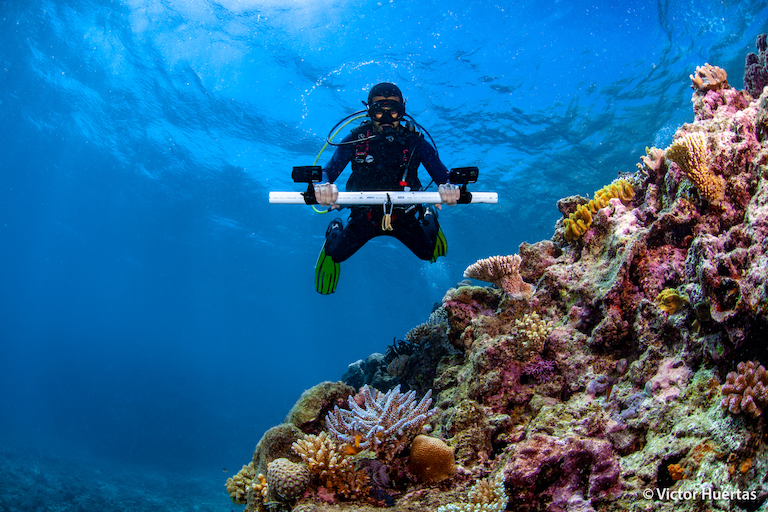- A new study finds that large, herbivorous fish species, such as parrotfish, surgeonfish and rabbitfish, benefit from coral reef demise due to an increase of a food source, algal turf.
- Certain fish species grew larger in response to coral loss and increased algal turf, contributing to an increase in reef fish biomass, although the study suggests that any gains would be short-lived.
- Data for this study were collected between 2003 and 2018 off the coast of Lizard Island on the Great Barrier Reef, which experienced coral reef losses of up to 83% due to mass bleaching events and cyclone destruction during that period.
When sea temperatures rise, coral reefs get “stressed out.” They expel a microscopic algae called zooxanthellae from their tissues, and this process causes colorful coral polyps to “bleach” a stark white hue. Without zooxanthellae, corals slowly starve and are left vulnerable to disease, and, in some cases, they even die off. Thousands of species, including sea anemones, clams and seahorses, depend on coral reef systems to survive, so they usually disappear, too.
But the loss of coral reefs isn’t bad news for everyone. A different type of algae, known as algal turf, will grow on the skeleton of the dead reef, and this provides a feast for large, herbivorous fish like parrotfish, surgeonfish and rabbitfish. The sudden increase in food causes these fish to grow even larger in size, according to a new study published in Functional Ecology.

“Because they now have more food … they just keep growing, and over the 15 years that our study spans, we would see more of the larger fishes,” Renato Morais, a doctoral candidate at James Cook University in Australia and lead author of the study, told Mongabay.
Morais and a team of international researchers collected data off the coast of Lizard Island, located on the Great Barrier Reef in Australia. Lizard Island, like much of the Great Barrier Reef, has experienced severe coral loss over the past decade due to mass bleaching events and destructive cyclone seasons. In fact, the reefs at Lizard Island experienced coral loss of about 83% between 2003 and 2018. In turn, the researchers found that algal turf on the reefs increased by 18% to 100%.
This resulted in a 71% increase in reef fish biomass, 41% in productivity and 37% in consumed biomass, mainly due to growth of herbivorous fishes, according to the study. This means that the reef had more energy in terms of fish weight, had the ability to produce more fish weight, and that fish were being readily consumed by predators.

But this doesn’t necessarily indicate that large, herbivorous fish were multiplying, or even that there was a stable population of fish, Morais said. It simply means that these larger fish were surviving on the reefs, while smaller fish may have died off or relocated following the demise of the reef system.
“Some of these [herbivorous] fishes can live up to 40 or 50 years, although most of them live between 10 and 30 years,” Morais said. “Many of these species were probably present in the same reef when it was surveyed 15 years ago. What might have happened is that those same fish, that were presumably small back then, grew up. They had food, they had a nice place to live … and that’s what might have driven these things.”
While species like parrotfish and surgeonfish might benefit from coral reef loss, any gains would be temporary, according to the study. Over time, a coral reef skeleton might erode, which would cause the algal turf to decrease. A coral reef system could also recover after a bleaching event, which would also spell the end of the carpet-like algae that herbivorous fish liked to feast upon. Not only that, but if older fish are not replaced by younger fish, reef productivity could actually collapse.

“Things can change very fast,” Morais said. “Something that’s happening now … might have an expiry date.”
Past studies have tended to take a static look at the impact of coral reef loss on fish, Morais said. But this study examines the cumulative effects of coral reef mortality over time by investigating fish growth, mortality and energy turnover. However, Morais said the results of the study are only applicable to the reefs off the coast of Lizard Island, although it’s likely that other reefs would be experiencing similar changes.
Morais says he hopes this study will be a springboard for further research.
“This study was an opening up of an idea, so that whoever is interested in thinking about that can start replicating,” Morais said. “We have the narrative up to a point, but I’d like to know what happens next, because that will be relevant to what we expect will happen in most coral reefs in the next decade.”
Citation:
Morais, R. A., Depczynski, M., Fulton, C., Marnane, M., Narvaez, P., Huertas, V. … Bellwood, D. R. (2020). Severe coral loss shifts energetic dynamics on a coral reef. Functional Ecology. doi:10.1111/1365-2435.13568
